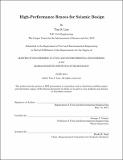High-performance braces for seismic design
Author(s)
Lim, Tim S
DownloadFull printable version (1.859Mb)
Other Contributors
Massachusetts Institute of Technology. Department of Civil and Environmental Engineering.
Advisor
Jerome J. Connor.
Terms of use
Metadata
Show full item recordAbstract
The fundamental challenge for the structural engineer in designing earthquake-resistant structures is to design buildings with both adequate ductility and sufficient stiffness. Traditional lateral force resisting systems such as the moment resisting frame and the concentrically braced frame are both conventional structural schemes that have been implemented for many years, but result in only mediocre performance levels. The lacking stiffness of a moment resisting frame as well as the limited ductility of a concentrically braced frame gave impetus for engineers to direct significant research efforts into the development of new lateral resisting systems that embody a more stable hysteretic behavior, adequate ductility, control of damage, and energy dissipating capacity. Fortunately, several recent developments have allowed engineers to move one step closer to designing more efficient earthquake-resistant structures. "High-performance braces," as this thesis calls them, are new and improved bracing systems that combine the economy and stiffness of a concentrically braced frame with the ductility and energy dissipating capacity of a moment resisting frame. This thesis analyzes and evaluates three different types of high-performance braces: (i) the buckling-restrained brace frame, (ii) the self-centering energy dissipating brace frame, and (iii) the hybrid brace frame, with regards to their structural performance and economy. The primary goal of the thesis is to provide useful insights into the current developments of high-performance braces for practicing engineers in the hope that such systems can be more widely adopted and utilized in the contemporary design of earthquake-resistant structures. Keywords: High-performance braces, earthquake-resistant structures, seismic design
Description
Thesis (M. Eng.)--Massachusetts Institute of Technology, Dept. of Civil and Environmental Engineering, 2013. This electronic version was submitted by the student author. The certified thesis is available in the Institute Archives and Special Collections. Cataloged from student-submitted PDF version of thesis. Includes bibliographical references (p. 73-79).
Date issued
2013Department
Massachusetts Institute of Technology. Department of Civil and Environmental EngineeringPublisher
Massachusetts Institute of Technology
Keywords
Civil and Environmental Engineering.